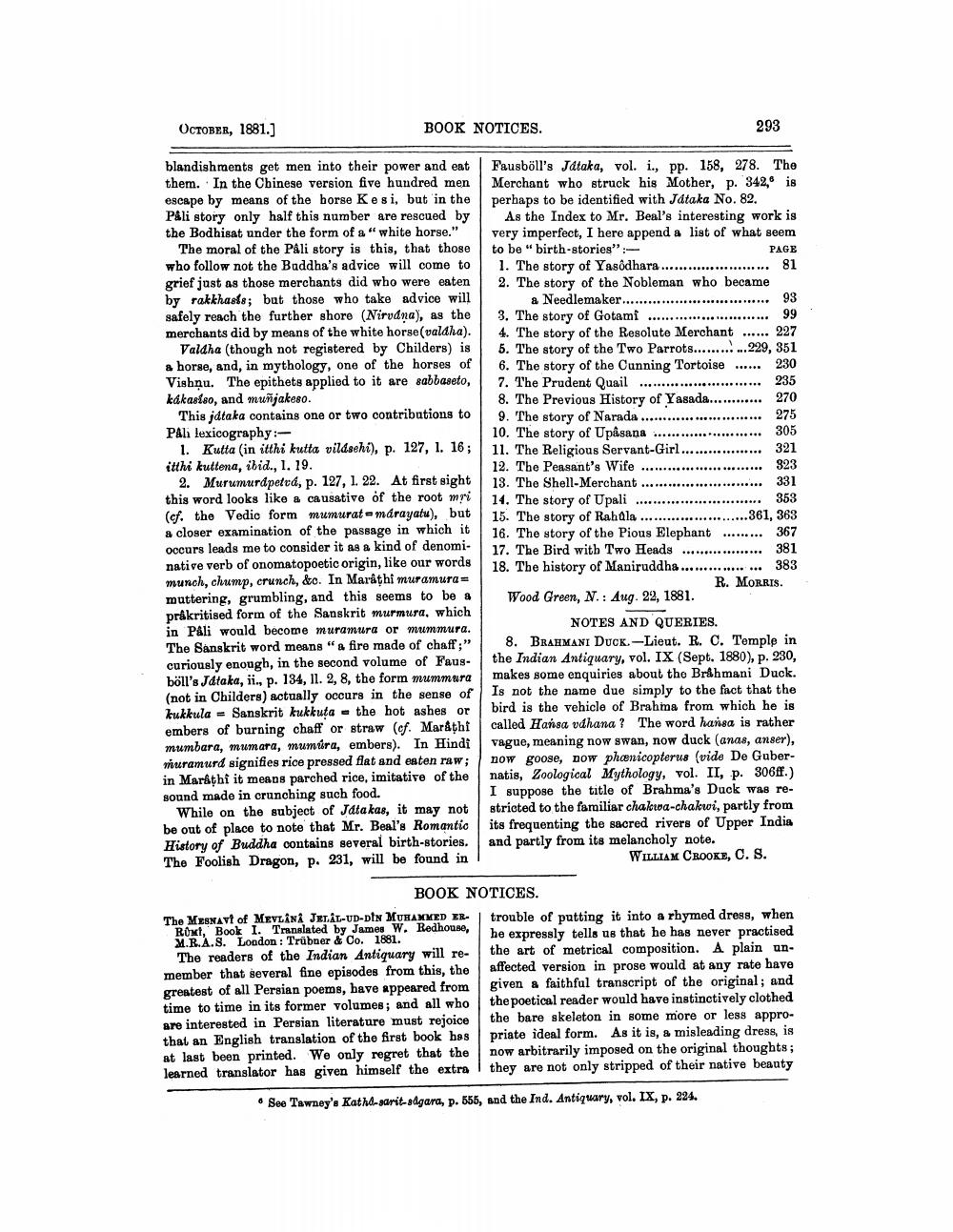________________
OCTOBER, 1881.]
BOOK NOTICES.
293
............
93
227
305 321
blandishments get men into their power and eat them. In the Chinese version five hundred men escape by means of the horse Kesi, but in the Pali story only half this number are rescued by the Bodhisat under the form of a "white horse."
The moral of the PAli story is this, that those who follow not the Buddha's advice will come to grief just as those merchants did who were eaten by rakkhaste; but those who take advice will safely reach the further shore (Nirvdna), as the merchants did by means of the white horse(valdha).
Valdha (though not registered by Childers) is a horse, and, in mythology, one of the horses of Vishnu. The epithets applied to it are sabbaseto, kákasiso, and muñjakeso.
This jdtaka contains one or two contributions to PÅli lexicography:
1. Kutta (in itthi kutta vildschi), p. 127, 1. 16; itthi kuttena, ibid., 1. 19.
2. Murumurdpetra, p. 127, 1. 22. At first sight this word looks like a causative of the root mri (cf. the Vedic form mumurat - mdrayatu), but a closer examination of the passage in which it occurs leads me to consider it as a kind of denominative verb of onomatopoetic origin, like our words munch, chump, crunch, &c. In Marathi muramura= muttering, grumbling, and this seems to be a pråkritised form of the Sanskrit murmura, which in Páli would become muramura or mummura. The Sanskrit word means "a fire made of chaff;" curiously enough, in the second volume of Fausböll's Jdtaka, ii., p. 134, II. 2, 8, the form mummura (not in Childers) actually occurs in the sense of kukkula - Sanskrit kukkuta - the hot ashes or embers of burning chaff or straw (cf. Marathi mumbara, mumara, mumúra, embers). In Hindi mineramurd signifies rice pressed flat and eaten raw; in Marathi it means parched rice, imitative of the sound made in crunching such food.
While on the subject of Jata kas, it may not be out of place to note that Mr. Beal's Romantic History of Buddha contains several birth-stories The Foolish Dragon, p. 231, will be found in
Fausböll's Jataka, vol. i., pp. 158, 278. The Merchant who struck his Mother, p. 342, is perhaps to be identified with Jataka No. 82.
As the Index to Mr. Beal's interesting work is very imperfect, I here append a list of what seem to be " birth-stories":
PAGE 1. The story of Yasodhara ..... ........... 2. The story of the Nobleman who became
a Needlemaker........ 3. The story of Gotami ........................... 99 4. The story of the Resolute Merchant ...... 5. The story of the Two Parrots...........229, 351 6. The story of the Cunning Tortoise ...... 230 7. The Prudent Quail ...............
235 8. The Previous History of Yasada........... 270
9. The story of Narada ....... 10. The story of Upâsana ............ 11. The Religious Servant-Girl......... 12. The Peasant's Wife ........................... 323 13. The Shell-Merchant ......
331 14. The story of Upali .............
353 15. The story of Rahola .........................361, 363 16. The story of the Pious Elephant ......... 367 17. The Bird with Two Heads ................... 381 18. The history of Maniruddha .................. 383
R. MORRIS. Wood Green, N.: Aug. 22, 1881.
NOTES AND QUERIES. 8. BRAHMANI DUCK.-Lieut. R. C. Temple in the Indian Antiquary, vol. IX (Sept. 1880), p. 230, makes some enquiries about the Brahmani Duck. Is not the name due simply to the fact that the bird is the vehicle of Brahma from which he is called Hansa vdhana ? The word hansa is rather vague, meaning now swan, now duck (anas, anser), now goose, now phanicopterus (vide De Gubernatis, Zoological Mythology, vol. II, p. 306ff.) I suppose the title of Brahma's Duck was restricted to the familiar chalua-chakwi, partly from its frequenting the sacred rivers of Upper India and partly from its melancholy note.
WILLIAM CROOKE, C. S.
BOOK NOTICES.
trouble of putting it into a rhymed dress, when RÜM, Book I. Translated by James W. Redhouse, M.R.A.S. Loodon : Trübner & Co. 1881.
he expressly tells us that he has never practised The readers of the Indian Antiquary will re- the art of metrical composition. A plain unmember that several fine episodes from this, the affected version in prose would at any rate have greatest of all Persian poems, have appeared from given a faithful transcript of the original; and time to time in its former volumes; and all who the poetical reader would have instinctively clothed are interested in Persian literature must rejoice the bare skeleton in some more or less approthat an English translation of the first book has priate ideal form. As it is, & misleading dress, is at last been printed. We only regret that the now arbitrarily imposed on the original thoughts; learned translator has given himself the extra they are not only stripped of their native beauty
• Seo Tawney'. Kathi-sarit-sdgara, p. 555, and the Ind. Antiquary, vol. IX, p. 224.




